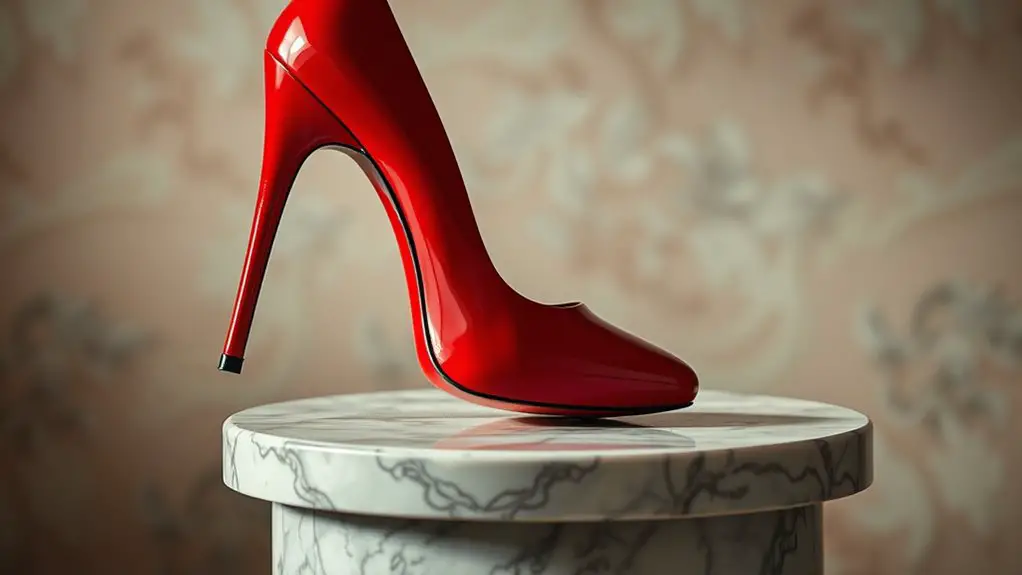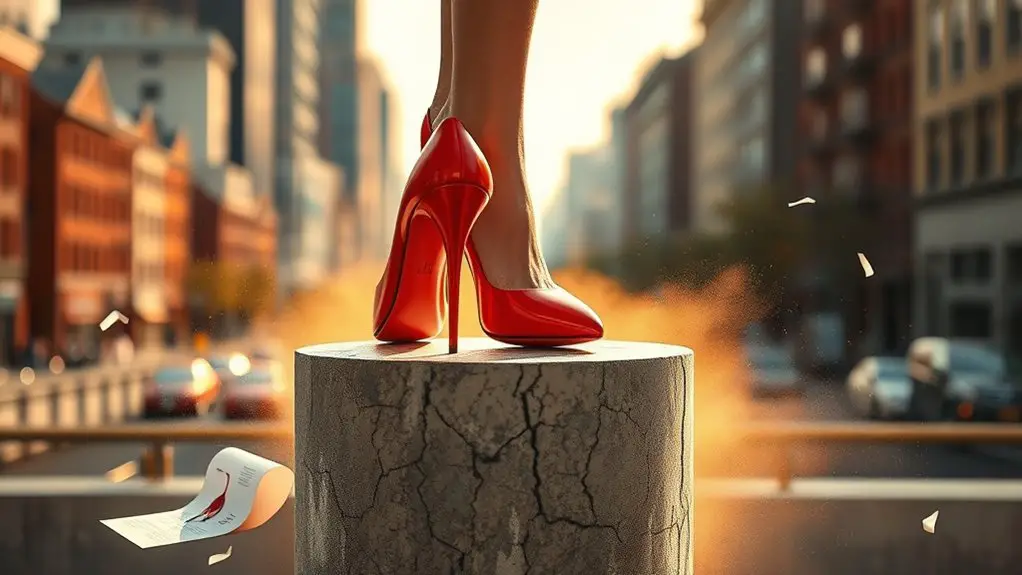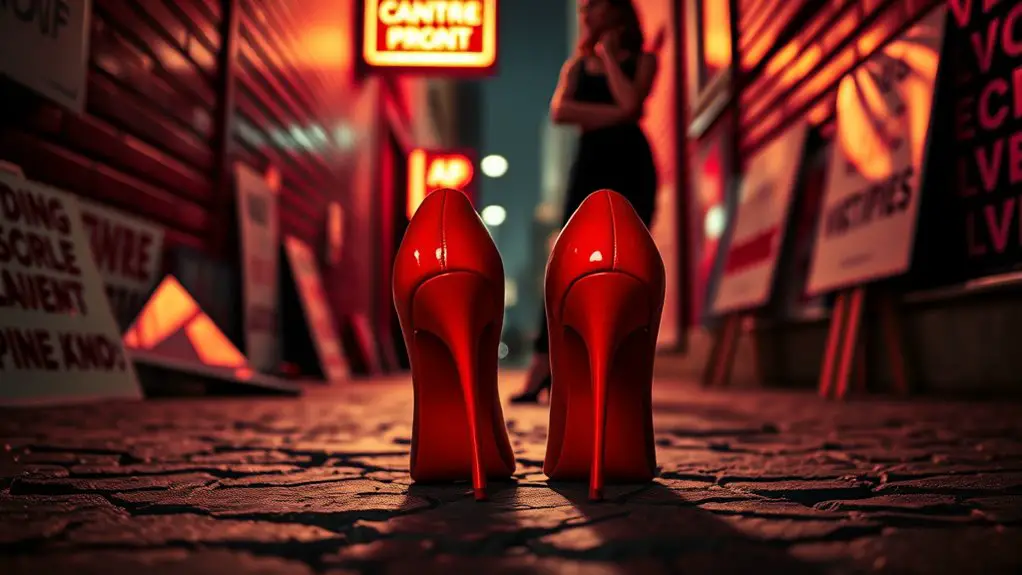Heels play a paradoxical role in feminism and empowerment. While they’re often seen as symbols of femininity and elegance, they also raise questions about autonomy and societal pressure. Wearing heels can boost your confidence but may also confine you physically and socially. Your choices reflect personal identity, yet they’re influenced by workplace norms and expectations. This dynamic reveals deeper tensions between empowerment and oppression, inviting you to explore how these narratives shape women’s experiences today.
The Historical Context of Heels in Women’s Fashion

Although high heels are often seen as a symbol of femininity today, their history reveals a complex interplay of power, class, and gender. Initially, heels emerged in the 15th century as practical footwear for Persian cavalry, symbolizing authority and height. As they evolved into women’s fashion, they took on a new historical significance. The shift in the 17th century saw aristocratic women donning heels to reflect status and wealth, manipulating societal norms around femininity and class.
This fashion evolution illustrates how heels often carried a dual purpose; they were a tool for empowerment yet also a means of confinement. By adopting high heels, women could challenge societal expectations, yet they also became enmeshed in a culture that dictated their appearance. Hence, the history of heels reflects more than mere aesthetics; it encapsulates the ongoing dialogue between power dynamics and identity, inviting you to reconsider their role in contemporary fashion.
Heels as a Symbol of Femininity
Heels have long been entwined with the concept of femininity, shaping how society perceives women’s roles and identities. You can see how the evolution of heels reflects cultural ideals, impacting everything from power dynamics to body image. As you explore this symbol, consider what it reveals about the expectations placed on women and the complex relationship between empowerment and appearance.
Historical Context of Heels
The evolution of high heels reflects a complex interplay between femininity and societal expectations. Originally worn by men for practicality in riding, heels transformed into symbols of femininity, steeped in historical significance. As fashion evolved, heels became a way for women to assert their identity within rigid societal confines. They signified not just beauty but also status and desirability, often constraining women’s mobility and autonomy. Yet, despite their restrictive nature, heels allowed women to navigate a male-dominated world, expressing power through fashion. This duality illustrates how heels embody both empowerment and oppression, revealing the intricate layers of femininity woven into their history. As you explore this context, consider how these dynamics continue to shape perceptions of femininity today.
Cultural Perceptions of Femininity
While many associate high heels with elegance and allure, they also serve as a battleground for cultural perceptions of femininity. These shoes embody feminine ideals, often reflecting society’s expectations of women to appear graceful and polished. Yet, they also raise questions about autonomy and authenticity in how you present yourself.
- Do you feel empowered or constrained in heels?
- Are you conforming to cultural expectations or embracing personal choice?
- How do heels influence your perception of femininity?
- Can you redefine strength while wearing them?
As you navigate these cultural waters, remember that heels can symbolize both empowerment and subjugation, depending on how you choose to wear them and the meaning you assign to your choices.
Heels and Body Image
High heels often serve as a potent symbol of femininity, shaping how women view their bodies and how they believe they should present themselves to the world. You might find that slipping into a pair can elevate your confidence, but it can also complicate your relationship with body image. Heels can enhance your silhouette, promoting a traditional standard of beauty that some women feel pressured to conform to. However, embracing body positivity means recognizing that self-expression comes in many forms—heels included or not. It’s crucial to question whether you’re wearing them for yourself or to meet societal expectations. Ultimately, true empowerment lies in your choice, whether you strut confidently in heels or celebrate your identity in other ways.
The Psychological Impact of Wearing Heels
When you slip on a pair of heels, you might notice a surge of confidence that alters your entire demeanor. This transformation isn’t just about height; it’s a complex interplay of how you express your feminine identity and how society perceives you. The psychological effects of those stilettos can be both empowering and constricting, revealing the duality of their impact in a world that often judges by appearances.
Confidence Boosting Effects
Many women report a surprising surge in confidence when they slip on a pair of heels, suggesting that the psychological impact of footwear can be profound. This self-esteem boost isn’t just about height; it’s about the transformative power of fashion. When you wear heels, you might find yourself standing taller, both physically and emotionally, which can enhance your overall fashion confidence.
- You command attention in a crowded room.
- You feel empowered to express your unique style.
- Your posture shifts, reflecting inner strength.
- You embrace your femininity unapologetically.
These effects highlight how something as simple as a shoe can alter your mindset, reinforcing the connection between personal style and self-empowerment in a complex society.
Feminine Identity Expression
Empowerment often intertwines with the act of self-expression, particularly in how women choose to present their identities through fashion. When you slip into a pair of heels, you’re not just elevating your stature; you’re engaging in a complex dance of feminine expression and identity politics. Heels can amplify your confidence and create a visual statement about your identity. They challenge societal norms while simultaneously adhering to them, allowing you to navigate the fine line between empowerment and expectation. This choice can reflect your inner strength or vulnerability, revealing the multifaceted nature of womanhood. Yet, it’s essential to recognize that this expression is personal; it’s about what resonates with you, not merely conforming to external pressures.
Societal Perception Influence
Although heels can serve as a powerful tool for self-expression, their psychological impact is often shaped by societal perceptions that can influence how you feel and act. When you slip into a pair, you might feel empowered or constrained by the weight of societal standards and fashion expectations.
- You may feel judged based on your choice of footwear.
- Heels can elevate your confidence, or they can amplify feelings of inadequacy.
- The pressure to conform can overshadow personal style and comfort.
- The allure of heels might mask a deeper struggle for autonomy in your choices.
Ultimately, the way you perceive heels is intertwined with the broader narrative of societal norms, challenging you to navigate empowerment within expectations.
Empowerment Through Personal Choice
When individuals embrace their choices, whether it’s slipping into a pair of heels or opting for flats, they redefine the narrative surrounding femininity and power. This act of personal expression is more than just a fashion statement; it’s a declaration of fashion autonomy. By choosing what to wear, you assert control over your identity and challenge societal norms that dictate how you should present yourself.
| Choice | Implication |
|---|---|
| Heels | Symbol of confidence and allure |
| Flats | Emphasis on comfort and practicality |
| Color | Reflection of personality |
| Style | Assertion of individuality |
| Occasion | Contextual expression of self |
Your decision reflects who you are and who you want to become. It’s about empowerment through the freedom to choose, allowing your attire to resonate with your true self, irrespective of external expectations.
Navigating Workplace Expectations and Heels

When you step into a workplace, you’re often met with an unspoken dress code that can feel more like a mandate than a choice. The pressure to wear heels may clash with your personal style and comfort, raising questions about conformity versus authenticity. As you navigate these expectations, consider how your footwear choices reflect not just your identity, but also the broader dynamics of power and gender in professional spaces.
Workplace Dress Codes
Traversing workplace dress codes can often feel like walking a tightrope, especially when it comes to the expectation of wearing heels. You might find yourself questioning whether these fashion choices enhance your professional image or simply conform to outdated norms.
- The pressure to fit into a narrow definition of office attire
- The discomfort that comes with sacrificing comfort for style
- The silent judgment when choosing flats over heels
- The empowerment found in reclaiming personal choice
Ultimately, steering through this landscape involves weighing societal expectations against your own comfort and identity. Are heels a tool for empowerment, or do they reinforce an archaic standard? In a modern workplace, it’s vital to reflect on what truly represents your professional image.
Personal Choice vs. Pressure
While the allure of heels can be enticing, the reality is that personal choice often collides with societal pressure in the workplace. You might feel empowered slipping on those stilettos, but are you truly expressing personal autonomy, or are you conforming to societal expectations? In many professional environments, heels are not just a fashion statement; they symbolize authority and competence. This creates a paradox: the desire to assert your identity can be overshadowed by the pressure to fit in. You may question whether your choice is genuinely yours or merely a response to an unspoken mandate. Maneuvering this tension requires introspection—consider what empowerment means for you. Ultimately, it’s essential to balance personal expression with the constraints imposed by the workplace.
Heels in Popular Culture and Media
High heels have been a staple in popular culture and media, symbolizing everything from femininity and power to objectification and discomfort. They’re not just heels in fashion; they’re a narrative device in cinema that shapes how we perceive women. You can see how they strut down runways or command attention in films, reinforcing ideals of beauty and success. Yet, this imagery often masks the realities of pain and societal pressure.
- The empowering click of heels on pavement.
- The seductive allure in a cinematic close-up.
- The relentless discomfort they impose on wearers.
- The dichotomy of confidence and struggle.
These elements provoke a complex relationship with heels, raising questions about whether they truly empower or merely reinforce traditional gender roles. In the end, you’re left pondering: are these symbols of strength or chains of expectation?
Challenging Gender Norms With Footwear

The narrative surrounding high heels often reinforces traditional gender norms, but footwear can also serve as a powerful tool for challenging these expectations. By embracing disruptive fashion, you can redefine what it means to express your identity. High heels, traditionally seen as symbols of femininity, can be subverted when combined with more androgynous styles or even worn by men. This blurring of lines not only challenges societal norms but also opens up conversations about gender expression, allowing you to engage with your identity in a multifaceted way.
When you wear footwear that defies convention, you’re not just making a fashion statement; you’re actively participating in a broader dialogue about empowerment. Each step you take in those shoes can disrupt the status quo, encouraging others to reconsider their own perceptions of gender. In this way, footwear becomes a potent medium for personal and collective transformation, pushing boundaries and inspiring change.
The Intersection of Comfort and Style
As you explore the relationship between comfort and style, it’s clear that these two elements don’t have to be mutually exclusive. In today’s fashion landscape, comfort trends are reshaping the narrative around heels, allowing for a style evolution that embraces both aesthetics and ease. You shouldn’t have to sacrifice one for the other, and the industry is finally catching up.
- Imagine striding confidently in chic heels that don’t pinch your feet.
- Picture yourself making a statement without enduring pain.
- Feel the empowerment that comes from choosing comfort without compromising style.
- Envision a world where your footwear reflects your identity and your well-being.
This intersection of comfort and style isn’t just a trend; it’s a movement. It challenges outdated perceptions, proving that you can be both fashionable and comfortable, ultimately redefining what empowerment looks like in your everyday life.
Voices of Women: Personal Stories and Experiences
Heels have long been a symbol of femininity, but the stories women share about their experiences with them reveal a complex narrative. Your personal narratives often intertwine empowerment with discomfort, illustrating a tension that many feel. You might find that the click of heels on pavement gives you confidence, yet you’re also painfully aware of the societal pressure to wear them. These shared experiences can be both unifying and isolating; while some celebrate heels as a tool for self-expression, others recount moments of vulnerability and pain.
As you listen to these voices, it’s clear that the journey with heels is deeply personal. Each story highlights not just the allure of style, but also the weight of expectation. In this landscape, heels can evoke feelings of strength or submission, depending on the perspective. Ultimately, your experiences with heels reflect broader themes of choice, identity, and empowerment in a complex world.
Redefining Empowerment in the Modern World
While society has long dictated what empowerment looks like, it’s crucial to recognize that true empowerment is about embracing individuality and choice. In today’s world, redefining empowerment means acknowledging that it can take many forms, often diverging from traditional norms. You have the power to choose what empowerment means for you, whether that’s wearing heels or opting for comfort.
Consider these modern perceptions of empowerment:
- Choosing your own path, regardless of societal expectations.
- Rejecting the notion that femininity is synonymous with weakness.
- Embracing vulnerability as a strength, not a flaw.
- Celebrating diversity in expressions of power and success.
Ultimately, empowerment isn’t one-size-fits-all; it thrives in the spectrum of personal choice. As you navigate this landscape, remember that your definition of empowerment is valid, powerful, and uniquely yours.
Frequently Asked Questions
Do All Women Feel Empowered Wearing Heels?
Not all women feel empowered wearing heels; it’s really about personal preference and individual expression. Some may find confidence in them, while others might feel restricted. What matters is how you define your own empowerment.
Are There Health Risks Associated With Wearing High Heels?
You might think high heels are stylish, but the health impacts can be serious. They alter foot anatomy, leading to pain and long-term issues. It’s essential to weigh aesthetics against potential risks to your well-being.
Can Heels Reinforce Traditional Gender Stereotypes?
Heels can indeed reinforce traditional gender stereotypes, as they often align with fashion expectations that dictate femininity. You might find that wearing them shapes your gender expression, impacting how others perceive your identity and authority.
What Alternatives Exist for Women Who Dislike Heels?
While heels scream sophistication, comfortable footwear like flats or stylish sneakers can offer equal allure without the discomfort. Embracing flat shoes not only prioritizes your comfort but also challenges conventional norms surrounding women’s fashion choices.
How Do Different Cultures View Heels and Empowerment?
Cultural perceptions of heels vary widely; in some societies, they symbolize empowerment and status, while others critique them as tools of oppression. Your understanding of global perspectives can reshape how you view these complex dynamics.



